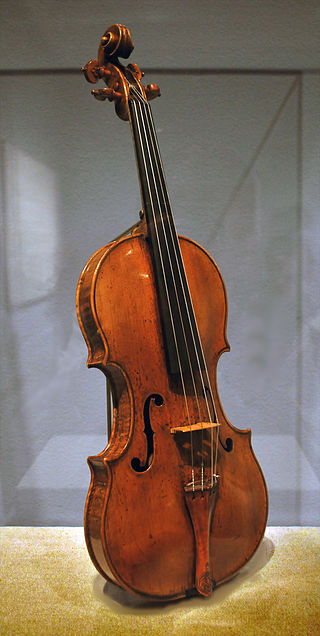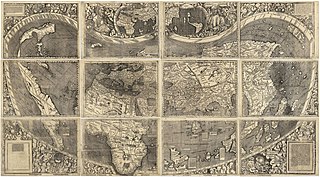
Amati is the last name of a family of Italian violin makers who lived at Cremona from about 1538 to 1740. Their importance is considered equal to those of the Bergonzi, Guarneri, and Stradivari families. Today, violins created by Nicolò Amati are valued at around $600,000. Because of their age and rarity, Amati instruments are mostly kept in museum or private collections and are seldom played in public.

Martin Waldseemüller was a German cartographer and humanist scholar. Sometimes known by the Latinized form of his name, Hylacomylus, his work was influential among contemporary cartographers. His collaborator Matthias Ringmann and he are credited with the first recorded usage of the word America to name a portion of the New World in honour of Italian explorer Amerigo Vespucci in a world map they delineated in 1507. Waldseemüller was also the first to map South America as a continent separate from Asia, the first to produce a printed globe, and the first to create a printed wall map of Europe. A set of his maps printed as an appendix to the 1513 edition of Ptolemy's Geography is considered to be the first example of a modern atlas.

The Cantino planisphere or Cantino world map is a manuscript Portuguese world map preserved at the Biblioteca Estense in Modena, Italy. It is named after Alberto Cantino, an agent for the Duke of Ferrara, who successfully smuggled it from Portugal to Italy in 1502. It measures 220 x 105 cm.

Johannes Schöner was a German polymath. It is best to refer to him using the usual 16th-century Latin term "mathematicus", as the areas of study to which he devoted his life were very different from those now considered to be the domain of the mathematician. He was a priest, astronomer, astrologer, geographer, cosmographer, cartographer, mathematician, globe and scientific instrument maker and editor and publisher of scientific tests. In his own time he enjoyed a Europe-wide reputation as an innovative and influential globe maker and cosmographer and as one of the continent's leading and most authoritative astrologers. Today he is remembered as an influential pioneer in the history of globe making, and as a man who played a significant role in the events that led up to the publishing of Copernicus's De revolutionibus orbium coelestium in Nürnberg in 1543.
Nicolò Gagliano, although there is some discussion about the exact dates), was an Italian violin-maker, the eldest son of Alessandro Gagliano. He made many admirable instruments, often imitated. Some have been mistaken for those of Stradivari. Nicolò was a more prolific maker than his brother Gennaro (Januarius). Nicolò and Gennaro are considered the greatest luthiers in the Gagliano family and the pinnacle of Neapolitan violin-making. Although Nicolò's work is not always entirely consistent in quality, it often shows great distinction. His instruments have bold and well-proportioned archings, with the instrument scrolls having a distinctive elongated pegbox and small tight spiral. He often placed a small label with a religious dedication inside his instruments.

The term "New World" is used to describe the majority of lands of Earth's Western Hemisphere, particularly the Americas. The term gained prominence in the early 16th century during Europe's Age of Discovery, after Italian explorer Amerigo Vespucci published the Latin-language pamphlet Mundus Novus, presenting his conclusion that these lands constitute a new continent. This realization expanded the geographical horizon of earlier European geographers, who had thought that the world only included Afro-Eurasian lands. Africa, Asia and Europe thus became collectively called the "Old World" of the Eastern Hemisphere, while the Americas were then referred to as "the fourth part of the world", or the "New World".

The Waldseemüller map or Universalis Cosmographia is a printed wall map of the world by German cartographer Martin Waldseemüller, originally published in April 1507. It is known as the first map to use the name "America". The name America is placed on South America on the main map. As explained in Cosmographiae Introductio, the name was bestowed in honor of the Italian Amerigo Vespucci.

The Caverio Map is a map drawn by Nicolay de Caveri or Caverio, circa 1506. It is kept at the Bibliothèque Nationale de France in Paris.

It has since been researched that Alessandro was never in Cremona at all. All folklore. As he learned locally from lute/violin makers, possibly 2 of them. So the Romance of him learning from Amati and Strad. is just a story. Perhaps his quality of varnish and workmanship led some to believe he learned in Cremona.
Bernard Wapowski (1475-1535) was one of the earliest Polish cartographers and is credited for making the first detailed map of Poland in 1526. Wapowski is considered to be the "Father of Polish Cartography". Wapowski served as the secretary of King Sigismund the Old and made several advancements in Polish cartography by creating several maps of Eastern Europe including Poland, Sarmatia, Scandinavia, Warmia (Ermland), and Pomerania with some assistance from Nicolaus Copernicus.

Moneglia is a comune (municipality) in the Metropolitan City of Genoa in the Italian region Liguria, located about 50 kilometres southeast of Genoa. It is a tourist resort on the Riviera di Levante. It is one of I Borghi più belli d'Italia.
The Contarini–Rosselli map of 1506 was the first printed world map showing the New World.
Nicolau is a Portuguese and Catalan given name, a variant of Nicholas. People known by this name include:

Nicolay – refer to Nobility particle) is a European noble family of the Ancien Régime with its roots in Southern France at the early part of the 14th Century. There is however, evidence to suggest that its origins stretch further back to the growth of the city state of Florence at the beginning of the Florentine Renaissance. The Nicolay family was originally associated with the French noble classes of the Nobles of the Robe and the Nobles of the Sword. It is well documented that members of the House of Nicolay became highly influential in the spheres of national government, law, the church, academia, military and diplomatic service, as well as the arts. They held the titles of marquis, count and baron.
Nicolai is a given name. Notable persons with that name include:

The Nicolaus Copernicus Monument in Warsaw is one of the Polish capital's notable landmarks. It stands before the Staszic Palace, the seat of the Polish Academy of Sciences on Krakowskie Przedmieście. Designed by Bertel Thorvaldsen in 1822, it was completed in 1830. Thorvaldsen's original plaster model from 1822 and a smaller study from 1821 are both held by the Thorvaldsen Museum in Copenhagen.

Castelo Real was a Portuguese castle established in Mogador, now Essaouira in Morocco, by the Portuguese in 1506.
Nicolao is an Italian given name and a surname. It may refer to the following:

The Egerton 2803 maps are an atlas of twenty Genoese portolan charts dated to around 1508 or 1510 and attributed to Visconte Maggiolo. The manuscript maps depict various regions of the Old and New Worlds, blending both Spanish and Portuguese cartographic knowledge. They have been noted as the earliest non-Amerindian maps of Middle America, and, jointly, as one of the oldest portolan atlases of the Americas. The maps were acquired for the Egerton Collection in 1895, published in facsimile form in 1911, and are now held by the British Library in London, England.












